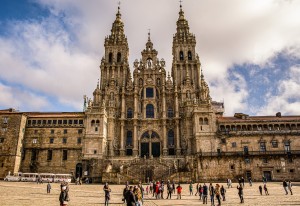This week International Women’s Day was celebrated, and that is why we wanted to dedicate this post to two brave women, who did not have it easy and who, even so, were true fighters. We are talking about Las Dos Marías. Maruxa and Coralia. This is his story.
It was the 50s and 60s in Santiago de Compostela. The sisters Maruxa and Coralia Fandiño Ricart, also known as Las Marías, Las Dos Marías or Las Dos en Punto, went out every noon to walk through the old part of the city.
These women attracted attention for their striking outfits, always very colorful, and for their quite extravagant makeup. They chose two in the afternoon, a very crowded time in the center for the students who went home to eat, to be seen.
Coralia, who was the younger of the two sisters, was more shy, while her older sister, Maruxa, was more self-confident. They were the twelfth and fourth daughters of a seamstress and shoemaker marriage with thirteen children.
Their hardships begin with the civil war. In 1925, when the CNT opened its headquarters in Santiago de Compostela, three of his brothers became militants. This anarchist movement, which was initially very well received, collapsed in 1936. During the Francoist repression his brothers had to escape and it was then that the Falangists decided to use the family to find his whereabouts.
Until two of the brothers were found and imprisoned, the two sisters suffered all kinds of mistreatment, even stripping them naked in public to make them feel ashamed.
Society itself judged them, often out of fear, treating them as “red” and even “prostitutes”. And her work, which until now had been seamstresses, was frustrated. Then they began to go hungry and had problems to survive.
Once the war ended, the neighbors began to help them by buying food.
Despite all these adversities, they never stopped wearing colors. Those colors that “transferred them to youth”.
Maruxa passed away in 1980 and Coralia just two years later.
But it was not until 1994 when the sculptor César Lombera managed to convince the then mayor of the city to allow him to place a sculpture in memory of the Fandiño sisters.
This statue is located at the entrance to the Alameda and it is a realistic reproduction of both during their walks.
Already in 2014, the Ateneo de Santiago Association managed to raise funds to rehabilitate the tombs of both sisters and continue their desire to be together. A plaque could also be placed in his memory.
And here we see another story of fighting women.











